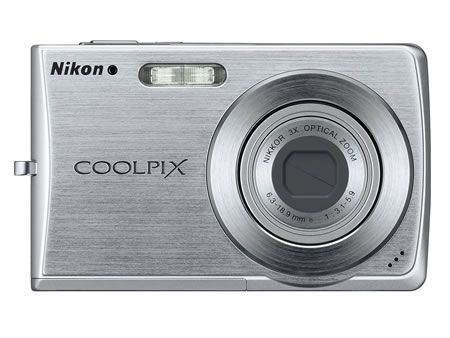The S200 impresses straight out of the box, it has a tough all-aluminium build and large screen that help make the new, slim line camera very nice to hold and to look at. Pleasing on the eye, it may be, but it also has some of Nikon’s signature features built into it that help make it that little bit extra eye catching.
Our quick take
The S200 could be looked at as a Coolpix S500-lite, but that fails to recognise the excellent build and features that make the S200 an accomplished machine in its own right at a good price.
Yes, the e-VR foibles mean if you have an extra £50, the S500’s optical image stabilisation might be a better option for you, but the otherwise excellent image quality, particularly below ISO 200 means the S200 is well worth looking at.
Overall, then, the camera works well, looks nice and takes cracking pictures.

Nikon Coolpix S200 digital camera - 4.0 / 5
| FOR | AGAINST |
|---|---|
|
|
The headline kit has to be the 7.1-megapixel sensor, which is similar to that housed within the S500 and, although the sensor sizes are the same (1/2.5-inch chips to be precise) the variation in the gross number of pixels varies slightly between the two, the S200 having slightly more.
The 3x optical zoom lens allows a 38-114mm focal range to be employed with modest maximum apertures of F3.1 to F5.9. It is for this reason the addition of image stabilisation is a useful tool, but unlike the S500, here Nikon have used their electronic Vibration Reduction (e-VR) system to help stop blur from camera shake for example. It sets the Hi Sensitivity mode and uses the Best Shot Selector (BSS) software.
This is good up to a point, but the high ISO setting adds image noise, the extra BSS processing can remove detail from a scene as it works through the image, removing blur. It also cannot deal with bad vibration problems so its effectiveness is questionable for those images on which you want it work best. It also slows down the camera’s shot-to-shot time as the camera locks up while it’s processing images. Hmm…
The control layout is basic, with an on/off button sitting next to a shutter release on the top and the “usual” array of buttons including a four-way job button, modem menu and playback control on the back – among others. The lens zoom control is a very thin sliver of metal across the top of the back plate and is fiddly to use.
The mode button is the opposite in terms of control, activating a new menu that allows you choose from the main shooting options of the “normal” Program AE setting, scene modes (chosen via a separate menu), the Hi ISO (1000) setting, the 640 x 480-pixel movie mode (with sound) and the One Touch Portrait feature (more of which in a moment) and an audio recording mode.
So far so similar to most cameras, but the One Touch Portrait mode is helpful in that it activates the Face Priority AF system and the only partially effective digital red-eye reduction system. This is great when shooting a complex scene and want to pick out a face or if you want to optimise the shot for a portrait because you can also adjust the way the image is dealt with by the camera either making it softer or brighter within menus.
One handling issue I found had a frustrating impact on performance. It is the way the S200 has many key features tucked away into menus: ISO and resolution and white balance, all key settings, require access to menus to change and where the S500 had a rotary selector to take some of the pain out of similar controls on that camera, there’s no such shortcut or fast operation options here.
The S200’s small built-in flash is great as a workaday fill-in for daylight shots but is underpowered for anything more than close-to shots when the light levels drop off. In terms of start up and shooting speed, it’s quick for normal snaps with very slight shutter lag, but the focus system takes a while to get going. Add the e-VR and other neat kit such as redeye reduction and the processing takes time, typically around one or two seconds per image depending on the extent of the problem.
Battery life is excellent however, I shot over 300 images with a fair mixture of flash and a great deal of reviewing images on the excellent, low-reflection 2.5-inch colour screen – many or my shots were taken at my daughters 3rd birthday party where the kids all wanted to look at the pictures on the camera.
Image quality is excellent overall, particularly at the lower ISO 50 and 100 settings. Over ISO 200, it’s good as noise starts to creep into images up to ISO 400 after which noise is obvious at ISO 800 and ISO 1000. Barring a little barrel distortion (at the wide end of the zoom) and some slight purple fringing, the S200 takes detailed, crisp pictures. The reliable (if slow) focus system and the very excellent metering also make significant contributions. White balance is also very good in all but mixed lighting where it starts to take on a slight orange cast.
To recap
The Coolpix S200 sits prettily below the recently tested S500 in Nikon’s “Style” range of Coolpix cameras
